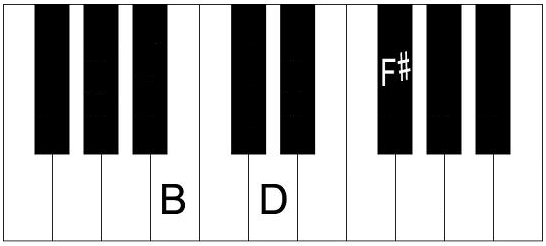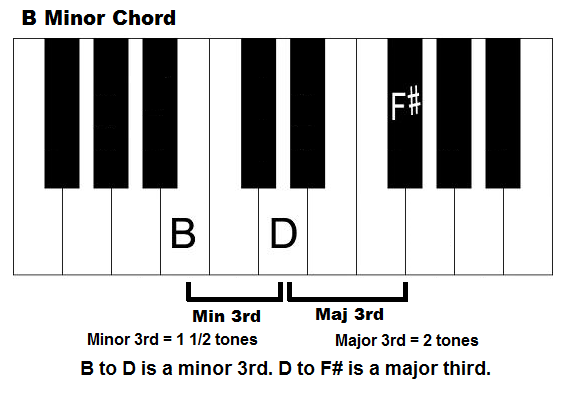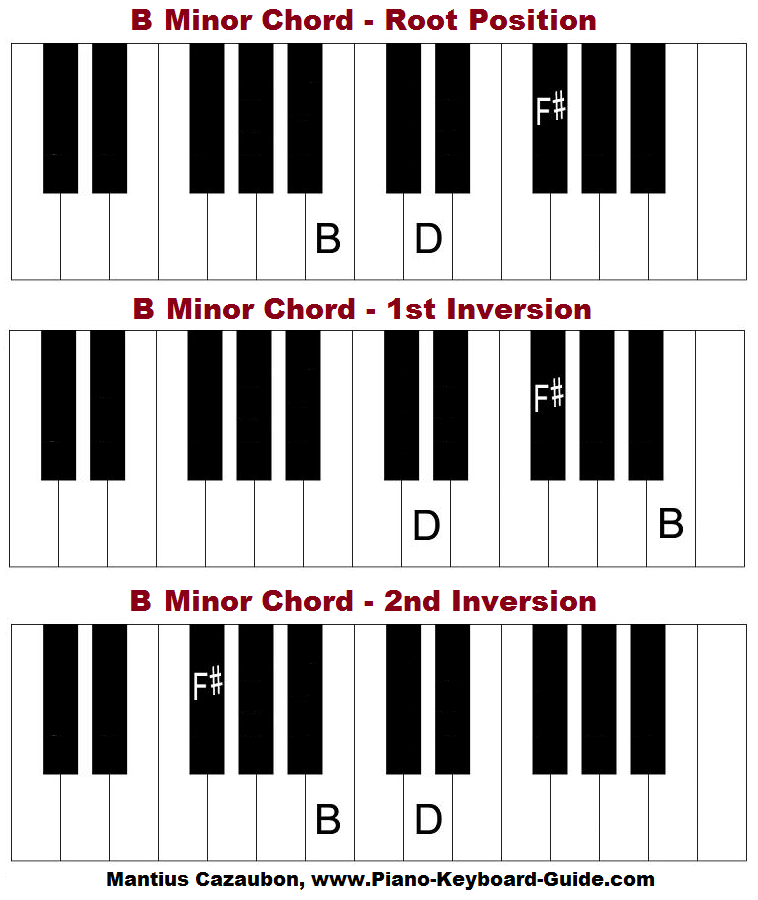In this lesson we will learn how to construct a B minor chord on piano. To form this chord, like any other minor triad, you combine the root, minor third (flat third) and perfect fifth of the major scale. In this case, it’s the B major scale. 
My #1 Recommendation: Go here to learn about the BEST piano/keyboard course I’ve seen online.
What do we mean by root, minor third and perfect fifth? Let’s take a look at the B major scale. Its notes are B – C# – D# – E – F# – G# – A# – B. In this scale, B is the root or tonic, C# is the major second, D# is the major third, E is the perfect fourth, F# is the perfect fifth, G# is the major sixth, A# is the major seventh and B is the perfect 8th.
To form a Bm chord, the third note of the scale D# must be played a semitone lower. Instead of D#, you play D. D# is the major third and D is the minor third. Hence the notes of the B minor chord are the root, B, the minor third, D and the perfect fifth, F#. B – D – F#. 
If you know how to play the B major chord, forming a B minor chord is as simple as lowering the middle note, D# in the chord by a half step. Simply replace D# with D.
Minor Chord Formula
The Bm chord and other minor chords can be formed by using the formula, R + 3HS + 4HS (root plus 3 half steps + 4 half steps). Find the note B on your piano keyboard. B is the key right after the set of three black keys. Now that you’ve located B, simple move 3 half steps higher to D, and from D, move 4 steps higher to F#.
Construct B Minor Chord by Skipping Keys
Another way to form a Bmin chord is by skipping keys. Start on B, then skip 2 keys. This will take you to D. After D, skip 3 keys and this will take you to F#.
Bm Chord in Root Position and Inversions
Until now, we’ve looked at the B minor chord in root position. We played the notes in the order, B – D – F#. There are other ways to hold this chord. In other words this chord has 2 inversions.
The first inversion is D – F# – B. Play the chord with D at the bottom, F# in the middle, and B at the top. 
The second inversion is F# – B – D. Play the chord with F# at the bottom, B in the middle and D at the top.
B Minor Chord Fingering
What is the fingering for the Bm chord? First of all chord fingering is not written in stone. It depends on what feels most comfortable since every hands is different. Here’s a possible right hand fingering.
To play Bm in root position with your right hand, place your thumb (1st finger) on B, your index finger (2nd finger) on D, and your ring finger (4th finger) on F#. Play the notes together to hear your B min chord. You can play 1 – 3 – 5 as well.
To play Bmin in the 1st inversion, place finger 1 on D, finger 3 on F# and finger 5 (little finger) on B.
To play B minor in its 2nd inversion, place your 1st finger on F#, 3rd finger (middle finger) on B and 5th finger on D.
Video: How To Play Bm on Piano
Here’s a video which shows how to play the Bmin chord in its root position and 1st and 2nd inversions.
The Bm chord occurs naturally in the following keys.
In the key of B minor, it’s chord i. In the key of D major, B minor is chord vi. In the key of E minor, it’s chord v. In the key of G major, it’s chord iii. In the key of F# minor, it’s chord iv. And in the key of A major, it’s chord ii.
Learn to play keyboards. Best recommendation.
Beginner Piano Lessons Home Page